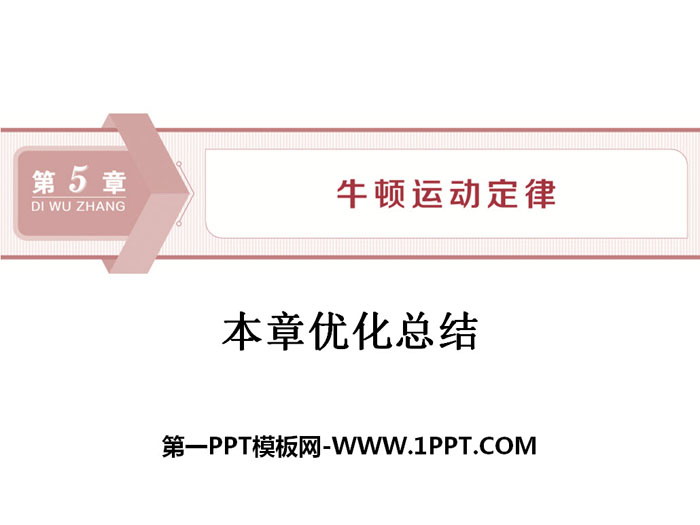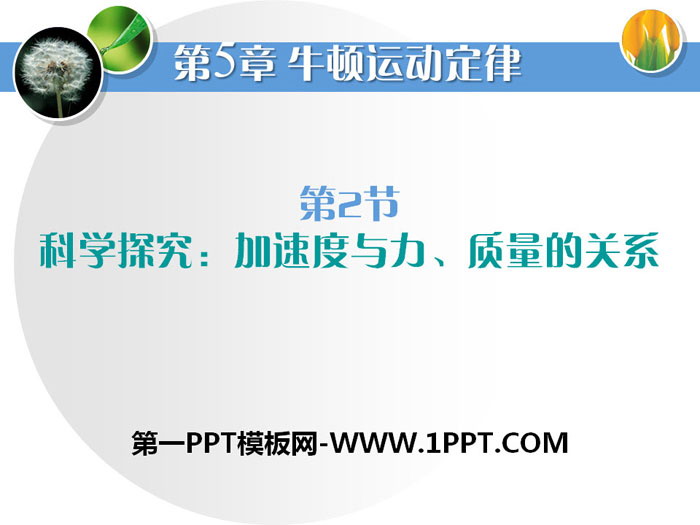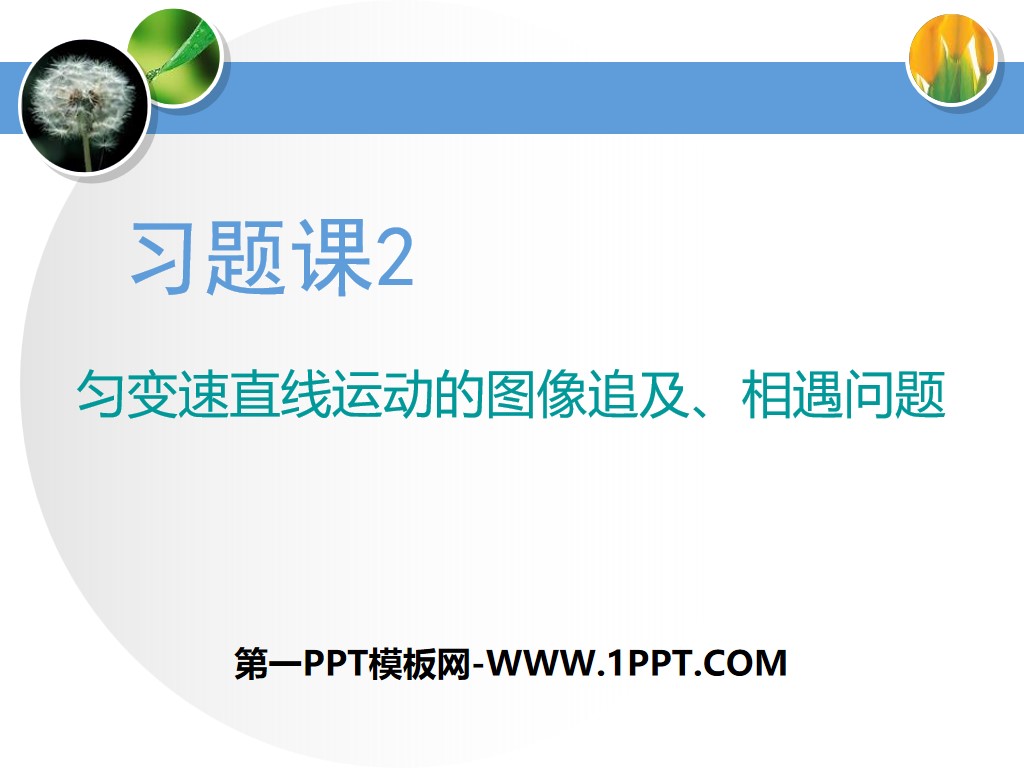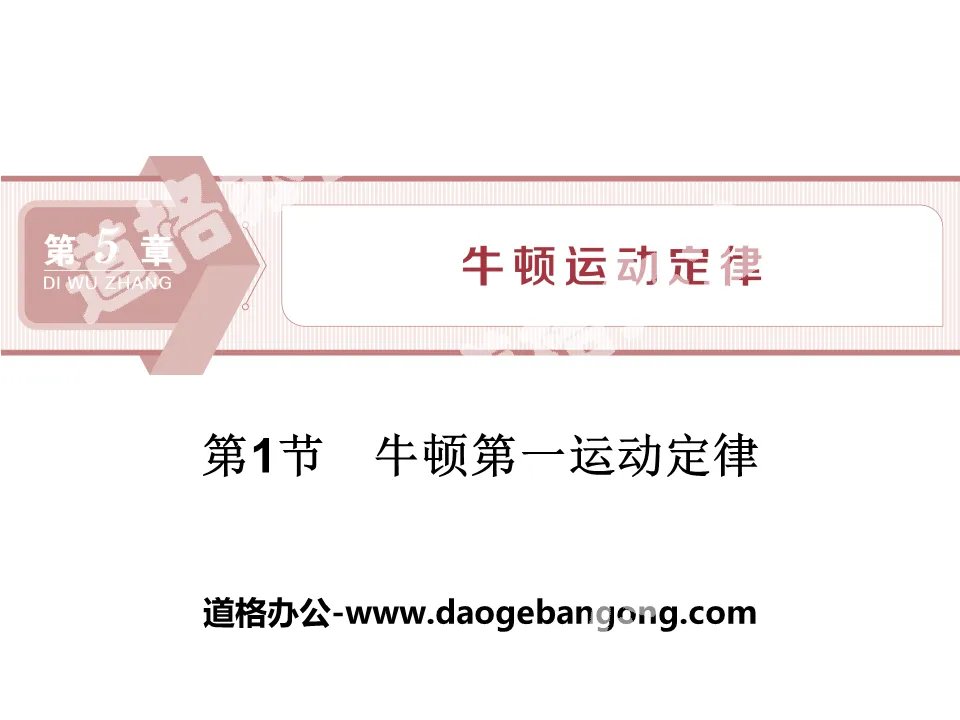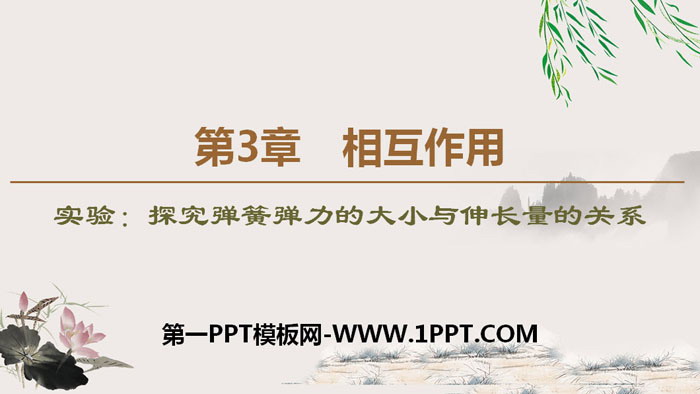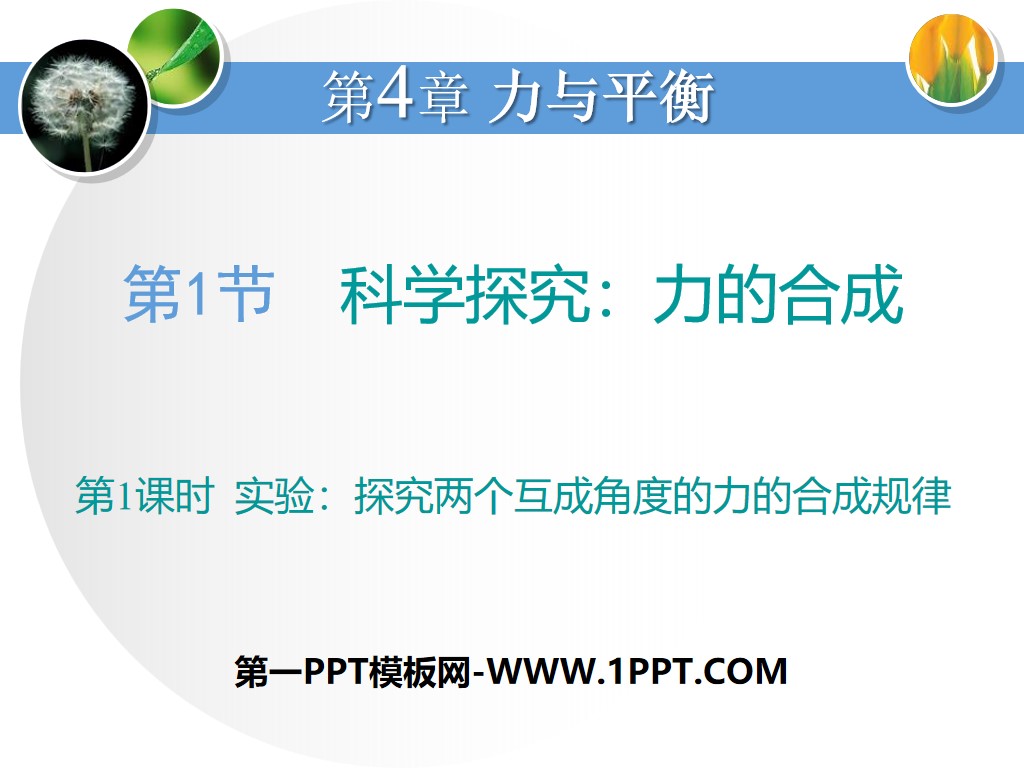
| Category | Format | Size |
|---|---|---|
| Lu Ke Edition High School Physics Compulsory Course One | pptx | 6 MB |
Description
"Scientific Inquiry: Synthesis of Forces" Force and Balance PPT (Experiment in Lesson 1: Explore the synthesis rules of two forces at angles to each other)
Part One: Experimental Basics
Purpose
1. Explore the relationship between two common point forces at an angle to each other and their resultant force.
2. Learn how to use equivalence ideas to explore vector synthesis.
experiment equipment
Wood board, rubber band, string, spring dynamometer, thumbtacks, white paper, pencil, scale, set square.
Experimental principles and design
1. Let two mutually angled common point forces F1 and F2 act on an object and produce obvious effects.
2. Use a force F to replace F1 and F2 to produce the same effect.
3. Measure F1, F2 and F, compare their sizes and directions, and find out the rules.
Experimental steps
1. As shown in Figure (a), on a wooden board covered with white paper, fix one end of the rubber band to point A with a thumbtack, and tie the other end to a node B with two thin lines. The spring dynamometers are hung on the two thin wires.
2. As shown in Figure (b), pull the two spring dynamometers respectively, and mark the stretched position of node B with a pencil, which is marked as point O. Write down the readings F1 and F2 of the two spring dynamometers at this time, and mark the direction of the force along the two thin lines.
3. As shown in Figure (c), pull a spring dynamometer hard. Also pull node B to O. Write down the reading F of the spring dynamometer at this time, and mark the direction of the force along the thin line.
4. Use force diagrams to draw F1, F2 and F.
Synthesis PPT of scientific inquiry ability, part 2: data analysis and conclusion
1. data analysis
(1) Comparing the sizes and directions of F1, F2, and F, can we see the relationship between the three? Give it a try and connect the arrow ends of F1, F2, and F with dotted lines to find out the satisfying rules and demonstrate them.
(2) Change the size and angle of the two forces F1 and F2, and repeat the above experiment twice.
2. Experimental results
Within the allowable range of experimental error, F is the resultant force of F1 and F2, and F1, F2 and F satisfy the parallelogram rule.
Error Analysis
1. During use, there is friction between the spring and the casing of the spring dynamometer, between the pointer and the casing, or between the casing and the paper surface of the spring dynamometer, which will cause systematic errors.
2. When measuring the tension twice, the knot of the rubber band cannot be completely pulled to the same point, causing accidental errors.
3. If the angle between the two component forces is too small or too large, and the values of F1 and F2 are too small, accidental errors will occur when the force diagram is drawn to calculate the resultant force.
Precautions
1. Node
(1) Be accurate when positioning nodes;
(2) The position of the rubber band node must remain unchanged in the same experiment.
2. pull
(1) When measuring the tension with a spring dynamometer, the tension should be along the axis of the spring dynamometer;
(2) The rubber band, spring dynamometer and string set should be located in the same plane parallel to the paper surface;
(3) The angle between the two components F1 and F2 should not be too large or too small.
Synthesis of scientific inquiry power PPT, part three: experimental test points
Test Point 1 Experimental Principles and Operations
[Typical Example 1] The experimental situation of a student doing "exploring the synthesis law of two mutually angled forces" is shown in Figure A, where A is the pushpin fixing the rubber band, O is the rubber band and the thin The knots of the rope, OB and OC are thin ropes. Figure B is a picture drawn on white paper based on the experimental results.
(1) If there is no operational error, among the two forces F and F′ in Figure B, the direction must be along the AO direction ________.
(2) The scientific method used in this experiment is ________.
A. Ideal experimental methodB. equivalent substitution method
C. Control variable method D. Establish physical model method
(3) During the experiment, the main steps are:
A. Place a square wooden board on the table, lay a piece of white paper on the square wooden board, and nail the white paper to the square wooden board with thumbtacks;
B. Fix one end of the rubber band to point A on the board with a thumbtack, tie two strings to the other end of the rubber band, and tie a noose to the other end of the string;
C. Use two spring dynamometers to hook the rope set respectively, pull the rubber band at an angle to each other, so that the rubber band stretches, the node reaches a certain position O, record the position of point O, and read out the two spring dynamometers. indication;
D. According to the selected scale, use a pencil and a scale to draw diagrams of the pulling forces F1 and F2 of the two spring dynamometers, and use the parallelogram rule to find the resultant force F;
E. Using only a spring dynamometer, pull the rubber band through the string sleeve to extend it. Read the reading of the spring dynamometer, note the direction of the string, and draw a diagram of the force F' on the same scale. ;
F. Compare the size and direction of F' and F to see if they are the same and draw a conclusion.
In the above steps,
①The serial numbers of the steps with important omissions are ________ and ________;
②The missing contents are _______________________________
and________________________________________________.
(3) The synthesis of force follows the parallelogram rule. The graphical representation of force must show the size, direction and point of action of the force. Therefore, in order to show the component force, its size and direction must be measured first, so the direction is omitted in step C. ; The resultant force and the component force are an equivalent substitution relationship. The premise of substitution is equivalence. In the experiment, the resultant force and the component force must cause the rubber band to produce the same deformation effect. Therefore, step E omits to make the nodes reach the same position. .
[Key Points]
(1) Each experiment must ensure that the position of the node remains unchanged, in order to make the effect of the resultant force the same as the effect of the two component forces acting together. This is the thinking method of equivalent substitution in physics.
(2) Since force is a vector, it not only has magnitude but also direction. During the experiment, the "directions of the two strings" must be recorded. When comparing, both magnitude and direction must be compared.
[Point-to-point training]
1. In the experiment of "Exploring the synthesis law of two forces at an angle to each other", a student used thumbtacks to fix the white paper on a horizontal wooden board, fixed one end of the rubber band to a point on the board, and two thin ropes Tie on the other end of the rubber band. Use two spring dynamometers to pull the two string sleeves respectively, and apply tension at an angle to each other, so that the rubber band stretches and the node reaches a certain position on the paper, as shown in the figure. Please complete the following experimental operations and processing:
① Use a pencil to trace the node position and mark it as O;
② Record the readings F1 and F2 of the two spring dynamometers, use a pencil to trace several points along the direction of each string (set), and use a scale to connect the corresponding points into lines;
Test Point 2 Data Processing and Error Analysis
[Typical Example 2] A certain research group conducts an experiment to "explore the synthesis law of two forces at an angle to each other". The coordinate axes will be drawn (the horizontal axis is the x-axis, the vertical axis is the y-axis, and the minimum scale The paper representing 1 mm) is attached to the horizontal table, as shown in Figure A. When one end Q of the rubber band is fixed at point B on the y-axis (located outside the part shown in the figure), and the other end P is located at point A on the y-axis, the rubber band is at its original length.
(1) Use a spring dynamometer to pull the P end of the rubber band from point A to the coordinate origin O along the y-axis. At this time, the magnitude of the pulling force F can be read by the spring dynamometer. The indication of the spring dynamometer is as shown in Figure B. The size of F is ________ N.
(2) Remove the tension in (1), and the P end of the rubber band returns to point A. Now use two spring dynamometers to pull the rubber band at the same time, and pull the P end to point O again. At this time, it is observed that the two tensile forces are along the directions shown by the two dotted lines in Figure A. The magnitude of the two tensile forces read from the spring dynamometer is F1 = 4.2 N and F2 = 5.6 N respectively.
[Key Points]
(1) When reading the spring dynamometer, the estimated number of reading digits must be determined based on the minimum scale, and the final reading must be given in the form of significant figures.
(2) The synthesis of forces follows the parallelogram rule. When drawing, use a scale and a triangle plate to draw.
Keywords: Free download of PPT courseware of Lu Ke version of high school physics compulsory course I, scientific exploration of the synthesis of forces PPT download, force and balance PPT download, exploration of the synthesis law of two mutually angled forces PPT download, .PPT format;
For more information about the PPT courseware "Force and Balance explores the law of synthesis of two forces at angles to each other and scientifically explores the synthesis of forces", please click Force and Balance ppt to explore the law of synthesis of two forces at angles to each other ppt Scientifically explores the synthesis of forces ppt label.
"End of Chapter Review Lesson" Force and Balance PPT:
"End of Chapter Review Course" Strength and Balance PPT Part One Content: Consolidation Level Knowledge Integration [Core Quick Filling] 1. Synthesis and decomposition of force (1) Obey the rules: _________ rule or _________ rule. (2) The range of the resultant force of two common point forces: _________F_______..
"Optimization Summary of this Chapter" Force and Balance PPT:
"Optimization Summary of this Chapter" Force and Balance PPT Integration Improvement Common Balance Model of Objects 1. Light rope model: The light rope can only stretch and deform, so it can only produce pulling force. The direction is always pointing in the direction of rope contraction, and the internal tension of the rope is equal everywhere. 2. Pulley model..
"Force Analysis and Balance of Common Point Forces" Force and Balance PPT:
"Force Analysis and Balance of Common Point Forces" Force and Balance PPT Part One Content: High-frequency Test Point 1 Force Analysis of Objects [Knowledge Comprehensive] 1. Force analysis: Analyze all the external forces that the research object (specified object) receives in the specified physical environment, and draw the object...
File Info
Update Time: 2024-07-06
This template belongs to Physics courseware Lu Ke Edition High School Physics Compulsory Course One industry PPT template
"Scientific Inquiry: Synthesis of Forces" Force and Balance PPT (Experiment in Lesson 1: Explore the synthesis rules of two forces at angles to each other) Simple campus recruitment activity planning plan summary enterprise and institution recruitment publicity lecture PPT template is a general PPT template for business post competition provided by the manuscript PPT, simple campus recruitment activity planning plan summary enterprise and institution recruitment promotion Lecture PPT template, you can edit and modify the text and pictures in the source file by downloading the source file. If you want more exquisite business PPT templates, you can come to grid resource. Doug resource PPT, massive PPT template slide material download, we only make high-quality PPT templates!
Tips: If you open the template and feel that it is not suitable for all your needs, you can search for related content "Scientific Inquiry: Synthesis of Forces" Force and Balance PPT (Experiment in Lesson 1: Explore the synthesis rules of two forces at angles to each other) is enough.
How to use the Windows system template
Directly decompress the file and use it with office or wps
How to use the Mac system template
Directly decompress the file and use it Office or wps can be used
Related reading
For more detailed PPT-related tutorials and font tutorials, you can view: Click to see
How to create a high-quality technological sense PPT? 4 ways to share the bottom of the box
Notice
Do not download in WeChat, Zhihu, QQ, built-in browsers, please use mobile browsers to download! If you are a mobile phone user, please download it on your computer!
1. The manuscript PPT is only for study and reference, please delete it 24 hours after downloading.
2. If the resource involves your legitimate rights and interests, delete it immediately.
3. Contact information: service@daogebangong.com
"Scientific Inquiry: Synthesis of Forces" Force and Balance PPT (Experiment in Lesson 1: Explore the synthesis rules of two forces at angles to each other), due to usage restrictions, it is only for personal study and reference use. For commercial use, please go to the relevant official website for authorization.
(Personal non-commercial use refers to the use of this font to complete the display of personal works, including but not limited to the design of personal papers, resumes, etc.)
Preview




